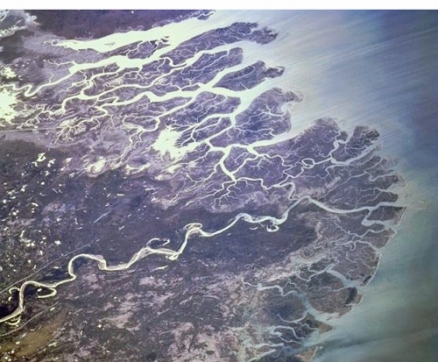Indus River Delta-Arabian Sea mangroves
The Indus River Delta-Arabian Sea mangroves ecoregion represents a mangrove habitat that is adapted to some of the most extreme temperatures and salinity conditions in the Indo-Pacific region. As a transition from the marine to freshwater and terrestrial systems, mangroves provide critical habitat for numerous species of fishes and crustaceans that are adapted to live among the tangled mass of pneumatophores, the roots that reach up from the muddy, anaerobic substrate to obrain the supply of oxygen for the mangrove trees.
Location and General Description
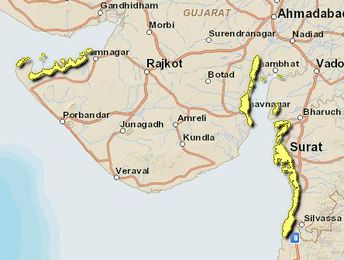 Indus River Delta-Arabian Sea mangroves ecoregion. WWF
Indus River Delta-Arabian Sea mangroves ecoregion. WWF
This ecoregion lies at the delta of the Indus River, which originates in the Tibetan Plateau and flows through the northwestern part of India and into the arid Thar Desert in Pakistan before finally emptying into the Arabian Sea. There are high salinity levels in the sloughs because of the high evaporation rates and the salts that are washed down by the river, which flows through a highly saline area. Climatic conditions are extreme. Ambient temperatures range from near-freezing temperatures in the winter to higher than 50 degrees Celsius during the summer. All rainfall is associated with the July to September southwest monsoon, which brings a mere 100 to 500 millimeters (mm) of precipitation.
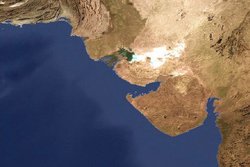 Satellite view of the Indus River delta and surrounding coastline in Pakistan and India. (Photograh by National Geographic Society) Mangroves in general are not biologically diverse compared with most other terrestrial ecosystems, and undisturbed mangrove forests have a dense canopy with little stratification and an undergrowth made up of seedlings and saplings from the canopy trees. The Indus River mangroves are even less diverse, being composed of nearly monospecific stands ofGrey Avicennia (Avicennia marina), a mangrove tree species very resistant to high salinity levels, and capable of surviving the [[region]'s] extreme meteorological conditions. Other species that are sometimes associated with the Avicennia include Rhizophora apiculata and Holy Mangrove tree (Acanthus ilicifolius), with occasional smaller patches of the Asiatic Mangrove tree (Rhizophora mucronata) and the Yellow Mangrove tree (Ceriops tagal) in scattered occurrences. The former mangrove species usually occurs in proximity to streambeds.
Satellite view of the Indus River delta and surrounding coastline in Pakistan and India. (Photograh by National Geographic Society) Mangroves in general are not biologically diverse compared with most other terrestrial ecosystems, and undisturbed mangrove forests have a dense canopy with little stratification and an undergrowth made up of seedlings and saplings from the canopy trees. The Indus River mangroves are even less diverse, being composed of nearly monospecific stands ofGrey Avicennia (Avicennia marina), a mangrove tree species very resistant to high salinity levels, and capable of surviving the [[region]'s] extreme meteorological conditions. Other species that are sometimes associated with the Avicennia include Rhizophora apiculata and Holy Mangrove tree (Acanthus ilicifolius), with occasional smaller patches of the Asiatic Mangrove tree (Rhizophora mucronata) and the Yellow Mangrove tree (Ceriops tagal) in scattered occurrences. The former mangrove species usually occurs in proximity to streambeds.
Biodiversity Features
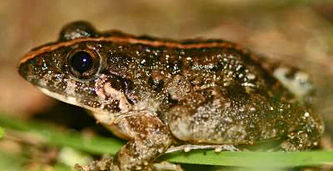 Indian Rice Frog. Source: Stepanka Nemcova /EoL This mangrove ecoregion provides important habitat for fish and invertebrates and serves as critically important spawning grounds and nurseries for fishes and aquatic crustaceans. Vertebrate species richness is modest, with a total of only 203 vertebrate taxa having been recorded in this ecoregion. There are 123 bird species known from this ecoregion, although none are considered endemic. Numerous mammals are found in the ecoregion, with an especially large number of bat taxa.
Indian Rice Frog. Source: Stepanka Nemcova /EoL This mangrove ecoregion provides important habitat for fish and invertebrates and serves as critically important spawning grounds and nurseries for fishes and aquatic crustaceans. Vertebrate species richness is modest, with a total of only 203 vertebrate taxa having been recorded in this ecoregion. There are 123 bird species known from this ecoregion, although none are considered endemic. Numerous mammals are found in the ecoregion, with an especially large number of bat taxa.
Amphibians
Only a single amphibian taxa is found in the Indus River Delta-Arabian Sea mangroves ecoregion: the anuran Indian Rice Frog (Fejervarya limnocharis), generally found in rice fields, ditches, marshes and floodplains.
Reptiles
There are only two species of reptile found in the ecoregion: Brahminy Blind Snake (Ramphotyphlops braminus); and the Critically Endangered Hawksbill Sea Turtle (Eretmochelys imbricata).
Mammals
A number of mammalian species are foun in the Indus River Delta-Arabian Sea mangroves, including: the Bonnet Monkey (Macaca radiata); Brandt's Hedgehog (Paraechinus hypomelas), a nocturnal animal found on clay and loess soils; Caracal (Caracal caracal); Egyptian Tomb Bat (Taphozous perforatus), found along rivers in rock shelters or tombs; Indian Crested Porcupine (Hystrix indica); Indian Muntjac (Muntiacus muntjak); the Vulnerable Rusty-spotted Cat (Prionailurus rubiginosus); and the Vulnerable Indian Smooth-coated Otter (Lutrogale perspicillata), who prefers rocky river stretches for cover.
Current Status
Although this ecoregion has been heavily degraded, and more than 85 percent of the habitat has been destroyed, several patches of intact habitat are extant. There are three protected areas that cover about 820 square kilometres (km2), or sixteen percent of the ecoregion (table 1), but even these protected areas are degraded.
Table 1. Protected Areas That Overlap with the Ecoregion.
|
|
|
|
|
Marho Kotri |
810 |
IV |
|
Cut Munarki Chach |
3 |
UA |
|
Mirpur Sakro |
10 |
IV |
|
Total |
823 |
Types and Severity of Threats
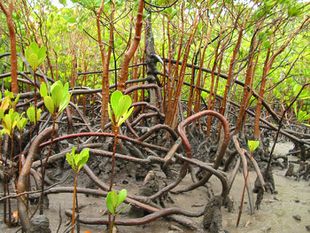 Yellow Mangrove propagules. Source: Griet Neukermans EoL
Yellow Mangrove propagules. Source: Griet Neukermans EoL
Threats to this mangrove ecoregion stem from several sources. Mangroves are exploited for fuelwood by local peoples, this being the major source of firewood for the more than 10,000 people who inhabit the area, and for fodder to feed their domestic livestock, including camels.
Other threats stem from industrial water pollutionoriginating from the city of Karachi, Pakistan; oil spills and discharges from ships that anchor in the city's harbour; and increased salinity levels caused by flow diversions in the Indus River. Seasonal fishermen live in the mangrove forests and cut and clear the forests in order to set up their camps.
References
- James M. Coleman; Huh, Oscar K.; Braud, DeWitte (2008). "Wetland Loss in World Deltas". Journal of Coastal Research 24: 1–14.
- Avijit Gupta, ed. 2008. "The Geographic, Geological and Oceanographic setting of the Indus river". Large Rivers: Geomorphology and Management. John Wiley & Sons. ISBN 9780470723715.
- Kumar Jain, Pushpendra K. Agarwal, Vijay P. Singh. 2007. Hydrology and water resources of India. 1258 pages Google eBook
- Altaf A. Memon (May 14–19, 2005). "Devastation of the Indus River Delta". World Water & Environmental Resources Congress 2005. Anchorage, Alaska: World Wildlife Fund.
This article was reviewed and approved by Topic Editors Mark McGinley and C. Michael Hogan
| Disclaimer: This article contains some information that was originally published by the World Wildlife Fund. Topic editors and authors for the Encyclopedia of Earth have edited its content and added new information. The use of information from the World Wildlife Fund should not be construed as support for or endorsement by that organization for any new information added by EoE personnel, or for any editing of the original content. |
